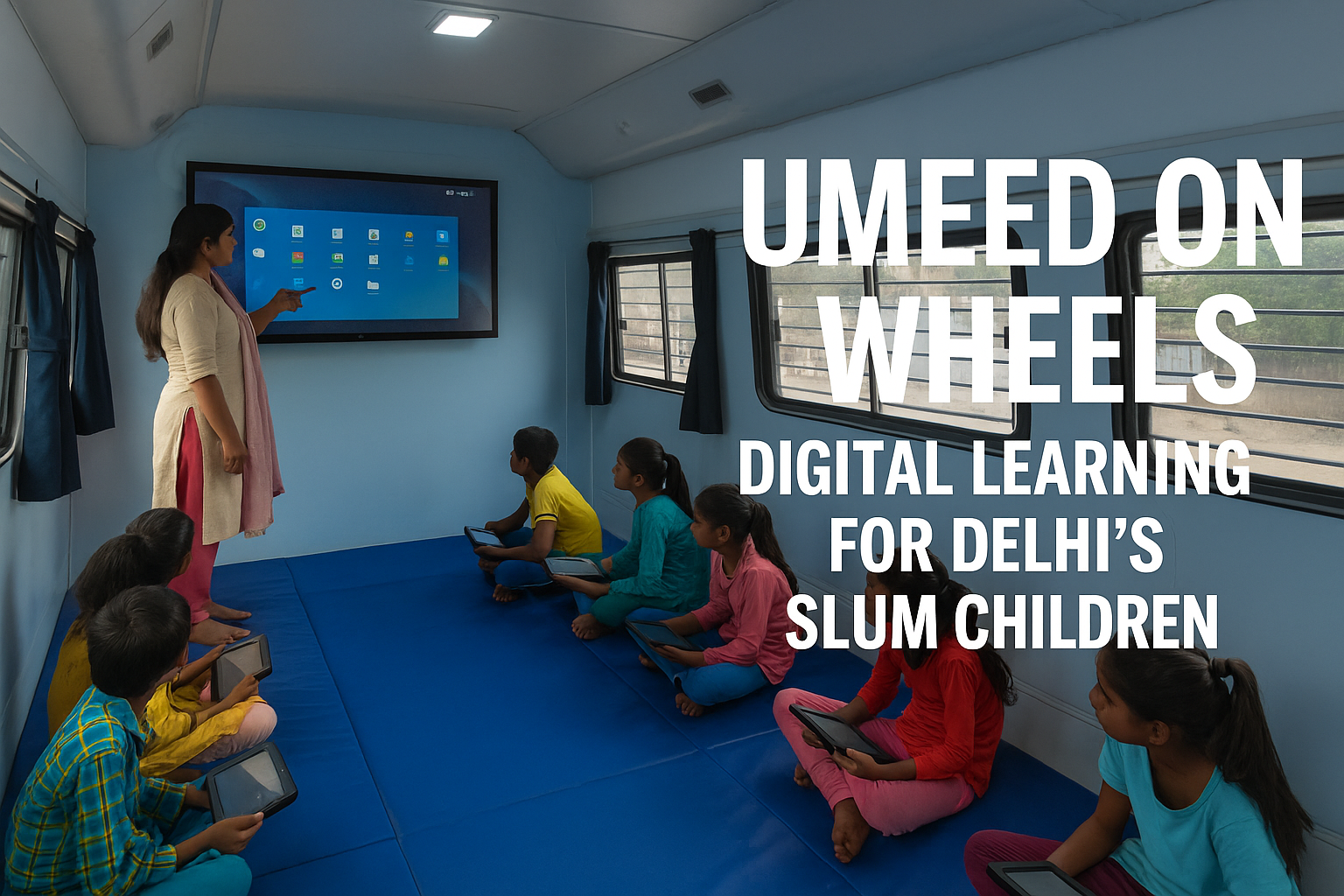In the dusty lanes of Delhi’s most neglected urban slums, hope now arrives on four wheels — in the form of a brightly painted, digitally equipped bus. Aptly named Umeed on Wheels (Hope on Wheels), this mobile digital classroom is changing the narrative for hundreds of out-of-school children who’ve long been invisible to the education system.
The Learning Crisis in Delhi’s Slums
According to 2024 estimates from Delhi Commission for Protection of Child Rights (DCPCR), over 75,000 children in the capital remain out of school. Many come from families grappling with poverty, displacement, migration, or lack of access to documentation — all of which create invisible barriers to formal education. A significant number of these children live in clusters like Seemapuri, Govindpuri, and Kirti Nagar, where schools are physically nearby but practically out of reach.
Enter Umeed on Wheels: A Classroom That Comes to Them
Umeed on Wheels is the brainchild of the Delhi Urban Shelter Improvement Board (DUSIB) in partnership with non-profits working in education and digital literacy. The vehicle is fitted with:
- Smart tablets and internet connectivity
- Interactive e-learning modules in Hindi and English
- Solar panels for sustainable power
- A team of trained instructors who double as community motivators
But this is more than just a bus. It is a bridge — between isolation and inclusion, between child labour and classrooms, between survival and aspirations.
“I Had Given Up on School” — First-Hand Stories from the Children
Ten-year-old Kavita, who lives near the Anand Parbat slum cluster, had dropped out after her parents couldn’t afford uniforms and books. “When the Umeed bus came, I got to touch a computer for the first time,” she says, proudly showing off her latest drawing on a tablet. She now dreams of becoming an art teacher.
Another student, Mohammad Irfan, aged 12, had never been to school. “I used to roam around, picking scraps. But now I’m learning math and English. I even taught my younger sister how to write her name.”
These stories aren’t anomalies — they are now becoming the norm.
Structured Learning with Measurable Impact
Each mobile classroom follows a structured yet flexible curriculum designed to cater to multi-age learners. Classes are held in two-hour shifts throughout the day to accommodate children who might have to assist their families with chores or informal work.
Impact Snapshot:
- Over 1,200 children reached across 17 slum clusters
- 65% retention rate after 3 months of engagement
- 300+ children have been mainstreamed into government schools
Beyond Academics: Instilling Confidence and Life Skills
The initiative also includes storytelling, hygiene education, and digital safety training. “We want them to learn not just ABCs but also how to use technology safely, speak confidently, and believe in their potential,” says Anjali Mehra, an education coordinator onboard.
Children participate in group reading, drama exercises, and community-led events — helping build social confidence that traditional education often overlooks.
Expert Voices Back the Initiative
Dr. Rajesh Tandon, founder of Participatory Research in Asia (PRIA), calls the initiative “a scalable innovation in urban educational equity.” He believes such mobile interventions are vital in cities where infrastructure gaps and migration dynamics leave many children stranded.
According to Manish Sisodia, former Delhi education minister, “Any intervention that goes to where the children are — rather than asking them to come to the system — is a step in the right direction.”
Community-Led, Government-Enabled: A Model Worth Replicating
What makes Umeed on Wheels unique is its hybrid approach. The Delhi government provides logistical and policy support, while NGOs manage community engagement, learning resources, and pedagogical design. Local volunteers, often women from within the same neighborhoods, assist in outreach and follow-up.
This collaborative, ground-up model ensures trust and continuity — two vital ingredients in engaging vulnerable children.
The Bigger Picture: Why Mobile Education Must Scale Up
While Umeed on Wheels is a beacon, it’s just one in a sea of need. With Delhi NCR’s slum population crossing 1.8 million, there is a pressing need for 10x more such mobile classrooms to close the access gap. Experts argue that similar buses could be deployed in peri-urban zones of Ghaziabad, Noida, and Gurgaon — where migrant labor populations face identical barriers.
Conclusion: More Than Education — It’s Dignity Delivered
Education isn’t just about literacy; it’s about dignity, inclusion, and the right to dream. Umeed on Wheels doesn’t just teach children — it reminds them they matter. And in a city where children are often forced to grow up too fast, a bus full of books and smiles may be the slow revolution they’ve been waiting for.
FAQs
What is Umeed on Wheels?
Umeed on Wheels is a mobile digital classroom launched in Delhi to bring education directly to out-of-school children living in urban slums. It is equipped with tablets, internet, and trained educators.
Who runs the Umeed on Wheels initiative?
The project is a collaboration between the Delhi Urban Shelter Improvement Board (DUSIB) and local NGOs working in education and community outreach.
How many children has the mobile bus helped so far?
As of 2025, Umeed on Wheels has reached over 1,200 children across 17 slum clusters in Delhi, helping many transition back into formal schooling.
Which areas of Delhi does the education bus cover?
It serves underserved neighborhoods such as Seemapuri, Kirti Nagar, Govindpuri, and Anand Parbat, where access to formal education is limited.
Can mobile classrooms really solve the education gap in slums?
While not a standalone solution, mobile classrooms offer immediate and scalable access to learning in hard-to-reach areas. They serve as vital bridges to mainstream education.

